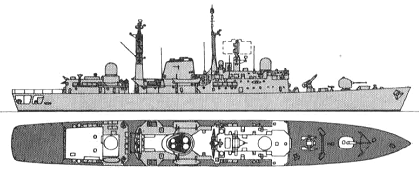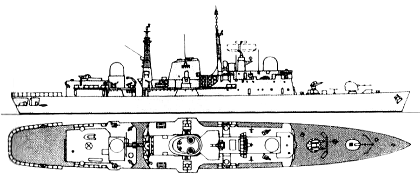

Sheffield 1980

Exeter 2000
| Name | No | Yard No | Builder | Laid down | Launched | Comp | Fate |
| Batch 1 | |||||||
| Sheffield | D80 | Vickers SB, Barrow | 15.1.1970 | 10.6.1971 | 16.2.1975 | sunk 4.5.1982 | |
| Birmingham | D86 | Cammell Laird, Birkenhead | 28.3.1972 | 30.7.1973 | 3.12.1976 | sold 10.2000 | |
| Newcastle | D87 | Swan Hunter, Wallsend | 21.2.1973 | 24.4.1975 | 23.3.1978 | sold 11.2008 | |
| Coventry | D118 | Cammell Laird, Birkenhead | 29.1.1973 | 21.6.1974 | 10.11.1978 | sunk 25.5.1982 | |
| Glasgow | D88 | Swan Hunter, Wallsend | 16.4.1974 | 14.4.1976 | 24.5.1979 | sold 12.2008 | |
| Cardiff | D108 | Vickers SB, Barrow // Swan Hunter, Hebburn | 6.11.1972 | 22.2.1974 | 24.9.1979 | sold 11.2008 | |
| Batch 2 | |||||||
| Exeter | D89 | Swan Hunter, Wallsend | 22.7.1976 | 25.4.1978 | 19.9.1980 | sold 9.2011 | |
| Southampton | D90 | Vosper Thornycroft, Woolston | 21.10.1976 | 29.1.1979 | 31.10.1981 | sold 10.2011 | |
| Liverpool | D92 | Cammell Laird, Birkenhead | 5.7.1978 | 25.9.1980 | 1.7.1982 | sold 10.2014 | |
| Nottingham | D91 | Vosper Thornycroft, Woolston | 6.2.1978 | 18.2.1980 | 14.4.1983 | sold 10.2011 | |
|
Displacement standard, t |
3560 |
|
Displacement full, t |
4250 |
|
Length, m |
119.5 pp 125.0 oa |
|
Breadth, m |
14.3 |
|
Draught, m |
4.30 hull 5.90 sonar dome |
|
No of shafts |
2 |
|
Machinery |
Batch 1: COGOG: 2 Rolls-Royce TM-3B gas turbines / 2 Rolls-Royce Tyne RM-1A gas turbines Batch 2: COGOG: 2 Rolls-Royce TM-3B gas turbines / 2 Rolls-Royce Tyne RM-1C gas turbines |
|
Power, h. p. |
Batch 1: 54400 / 8200 Batch 2: 54400 / 10680 |
|
Max speed, kts |
28 |
|
Fuel, t |
gas turbine oil 600 |
| Endurance, nm(kts) | 4500(18) |
|
Armament |
D80: 1 x 2 Sea Dart GWS30 SAM (22 Sea Dart), 1 x 1 - 114/55 Mk 8, 2 x 1 - 20/70 Mk 7A, 1 helicopter (Lynx) D86-90, 108, 118: 1 x 2 Sea Dart GWS30 SAM (22 Sea Dart), 1 x 1 - 114/55 Mk 8, 2 x 1 - 20/70 Mk 7A, 2 x 3 - 324 STWS.2 TT, 1 helicopter (Lynx) D91, 92: 1 x 2 Sea Dart GWS30 SAM (22 Sea Dart), 1 x 1 - 114/55 Mk 8, 2 x 2 - 30/75 GCM-A03, 2 x 1 - 20/90 GAM-B01, 2 x 1 - 20/70 Mk 7A, 2 x 3 - 324 STWS.2 TT, 1 helicopter (Lynx) |
|
Electronic equipment |
D80, 86-88, 108, 118: type 965M AKE-2, type 992Q, type 1006, 2x type 909 radars, type 162M, type 184M sonars, type 670, UAA(1) ECM suites, 2x Corvus decoy RL, 4x DLF(2) floating decoy launchers, type 182 torpedo decoy, ADAWS-4 CCS D89, 90: type 1022, type 992Q, type 1006, 2x type 909 radars, type 162M, type 184M sonars, type 670, UAA(1) ECM suites, 2x Corvus decoy RL, 4x DLF(2) floating decoy launchers, type 182 torpedo decoy, ADAWS-7 Mod.1 CCS D91, 92: type 1022, type 992Q, type 1006, 2x type 909 radars, type 162M, type 184M sonars, type 670, UAA(1) ECM suites, 4x DLD decoy RL, 4x DLF(2) floating decoy launchers, type 182 torpedo decoy, ADAWS-7 CCS |
|
Complement |
253 |
Project history: The cancellation of CVA-01 led to a new Staff Requirement for a smaller fleet escort capable of providing area defence. The result was the Type 42 guided missile destroyer (DDG), which achieved significant savings on cost and displacement by dropping the Ikara long-range ASW missile and Limbo mortar and adopting an all-gas turbine (COGOG) propulsion system, using Rolls-Royce Olympus turbines for main drive and Tynes for cruising.
Although lacking Ikara, the ASW capability was greatly improved over previous ships by providing a hangared Lynx light helicopter (armed with torpedoes and missiles). Unlike Bristol the forecastle deck extends right aft to form the helicopter flight deck, leaving a small covered quarterdeck below for handling mooring wires. Close-range ASW defence was provided by triple TT similar to the USN Mk 32, firing Mk 44 or Mk 46 weapons, but eventually to fire the new Stingray lightweight torpedo. Apart from having the Sea Dart twin-arm launcher forward (a lighter hand-operated version of the type in Bristol), the configuration was similar to Bristol: Type 909 Sea Dart trackers forward and aft and a Type 965 (AKE-2) air warning radar above the forward superstructure.
The appearance was quite different from previous DLGs, with a single wide funnel. Sheffield appeared with prominent 'Loxton Bends' on each side, an attempt to keep her heat signature down, but this was not repeated in following ships. Exeter commissioned in 1980 with the new Type 1022 interim STIR radar in place of the double 965, and this set was retro-fitted to the earlier ships. Sheffield did not receive her STWS TT, but the others carried them on small platforms abreast the mainmast.
The main weakness of the Sheffield class lay in the constraints placed on dimensions during the design phase. As a result of Treasury pressure the length and beam were kept down, resulting in cramped accommodation and reduced endurance. The problem of endurance was shrugged aside on the grounds that the ships had no 'east of Suez" role and would always be within reach of a replenishment group around the coasts of northwestern Europe, but the short forecastle affects their seaworthiness by making them very wet forward. This fault has been rectified in later vessels (see below), but it places severe limits on what can be added to the surviving ships.
The high degree of automation had resulted in a reduction of one hundred men over Bristols complement. The layout of the machinery compartments allows easy removal routes, and a complete change of gas turbine can be carried out by the ship herself: all that was needed was a sheltered anchorage and a crane capable of lifting the turbine in its module.
Cardiff was seriously delayed by a shortage of skilled manpower at Barrow-in-Furness and had to be towed to the Tyne in February 1976 for completion by Swan Hunter. Liverpool was the first to be built by the 'extrusion' method: large sections of hull were built separately and then moved on to the slipway. This enabled Cammell Laird to cut delivery time by a year.
Modernizations: 1982, Birmingham: + 2 x 2 - 30/75 GCM-A03, 2 x 1 - 20/90 GAM-B01
1982, Newcastle, Glasgow, Cardiff, Exeter, Southampton: - 2x Corvus decoy RL; + 2 x 2 - 30/75 GCM-A03, 2 x 1 - 20/90 GAM-B01, 4x DLD decoy RL
mid-1980s, Birmingham, Nottingham: - 2 x 1 - 20/70; + 2 x 1 - 20/90 GAM-B01
1984-1989, Newcastle, Glasgow, Cardiff: - 2 x 2 - 30/75, type 992Q, type 965M (AKE-2) radars, type 184M sonar, UAA(1), type 670 ECM suites, ADAWS-4 CCS; + 2 x 6 - 20/76 Mk 15 Phalanx, type 996, type 1022, 2x Mk 90 radars, type 2016 sonar, UAA(2) , type 675 ECM suites, type 182 torpedo decoy, 2x DEC laser dazzlers, ADAWS-7 CCS
1987-1989, Birmingham: - 2 x 2 - 30/75, type 965M (AKE-2) radars, type 184M sonar, UAA(1), type 670 ECM suites, ADAWS-4 CCS; + 2 x 6 - 20/76 Mk 15 Phalanx, type 1022, 2x Mk 90 radars, type 2016 sonar, UAA(2), type 675 ECM suites, type 182 torpedo decoy, 2x DEC laser dazzlers, ADAWS-7 CCS
1987-1989, Exeter, Southampton, Liverpool, Nottingham: - 2 x 2 - 30/75, type 992Q radar, type 184M sonar, UAA(1), type 670 ECM suites; + 2 x 6 - 20/76 Mk 15 Phalanx, type 996, 2x Mk 90 radars, type 2050 sonar, UAA(2), type 675 ECM suites, type 182 torpedo decoy, 2x DEC laser dazzlers
2000, all survived: - 2 x 3 - 324 TT, type 1006 radar, type 675 ECM suite; + type 1007, type 1008 radars
2000, Exeter, Southampton: - UAA(2) ECM suite; + UAT(5) ECM suite
2001, Newcastle, Exeter, Southampton, Liverpool: - 2 x 1 - 20/70
early 2000s, some ships: - 4x DLF(2) floating decoy launchers, type 182 torpedo decoy; + 4x DLF(3) floating decoy launchers, type 2070 torpedo decoy
Naval service: Sheffield was disabled and set on fire by unexploded Argentine AM39 Exocet missile launched by Super Étendard attacker on 4 May 1982 off Falklands; the wreck was scuttled 10 May. Coventry was sunk by 3 bombs from Argentine A-4 Skyhawk attackers on 25 May 1982 off Falklands. Glasgow was hit by 1000pdr bomb from Argentine aircraft 12.5.1982, bomb pierced the hull of the ship from side to side but did not explode. Southampton was badly damaged on 3 September 1988 a collision with a roll-on/roll-off ship in the Persian Gulf: she was rebuilt on the Tyne during 1989-91.

Sheffield 1981

Newcastle 2003
© Ivan Gogin, 2016